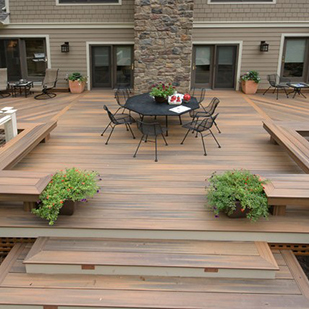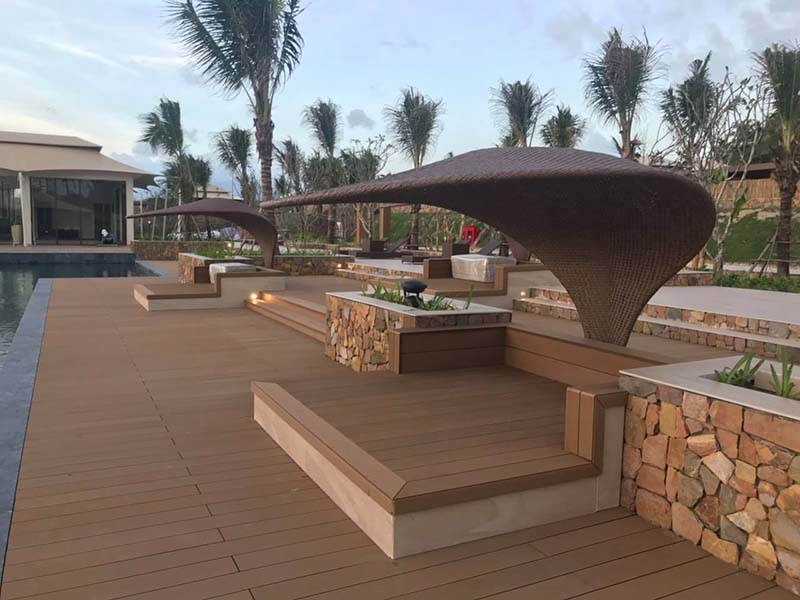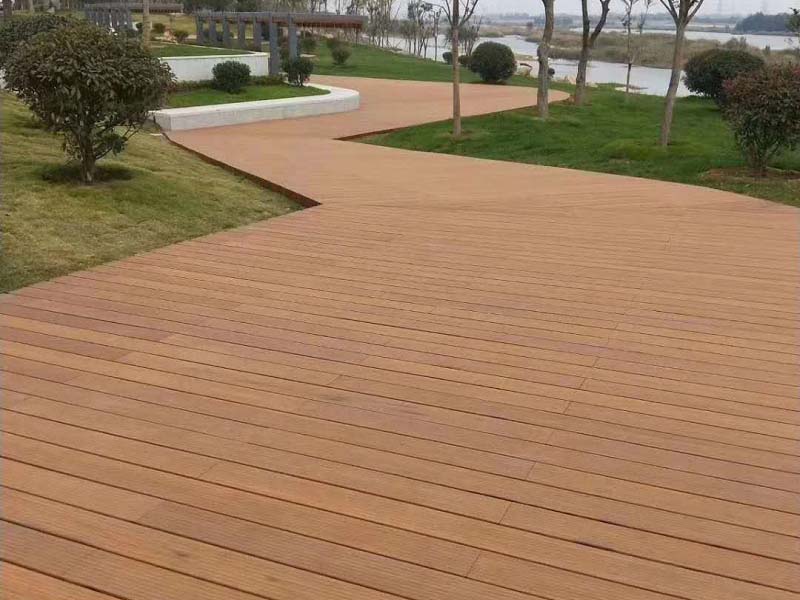Jul. 10, 2021
Wood plastic composite material are introduced into our common building decoration sector in recent years. Along with the technical innovation of wood plastic composite extrusion, it indeed performs better in outdoor environment. But some bad performance like crack,deformation also happens in some projects especially which are installed around swimming pool or lake.The core reason is due to the creep characteristic of wood plastic composite material itselt. Correct installaion helps recude the risk of deformation.
 Water swelling and creep
Water swelling and creep
During the rainy season, the wood-plastic material absorbs water and expands, and the wood-plastic material produces a small amount of creep elongation, which can not be restored; and with the alternating cycle of dry and wet, it periodically generates creep elongation and overlaps. As the internal wood of the wood plastic composite reaches the possible water swelling limit and the binding force of the polymer material, the increment of the water swelling creep elongation gradually decreases to zero, reaching the creep limit. Plastic-wood material creep is the combined result of temperature stress creep superposition and water-absorbing swelling creep. When the two ends of wood-plastic material are fixed and restrained, with the superposition of various creeps of plastic-wood material, it is a beautiful linear material when it is built. , And gradually appear obvious bending; and alternate between several cold and heat.
Design solutions for the deformation of wood plastic materials.The moisture absorption of the polymer base in the plastic wood material is very small, and the moisture absorption of the plant fiber is large; the effective treatment of the plant fiber greatly reduces hygroscopicity is very important. In formula design and process design of wood plastic materials, the water absorption of wood plastic materials must be reduced as much as possible.
In the end, strict water absorption is used as the quality index assessment; temperature stress and creep are determined by the characteristics of the material itself, and improvement plans must be found from the polymer material itself. Controlling and reducing the linear expansion coefficient of plastic wood materials can effectively control and reduce temperature stress.
Temperature stress and creep
The temperature rises in summer, and the wood plastic material produces thermal expansion. Longer WPC decking board has greater thermal expansion. Because the two ends are fixed, the temperature stress is also large (the stress and expansion are proportional to the deformation). When the expansion reaches a certain value, the decking board will be unstable and bend and bend with the increase of thermal expansion. Degree (bending deformation) increases. If the installation is in a high temperature season, the temperature difference from the maximum temperature is small, and there is basically no bending and deformation due to thermal expansion. However, in the low temperature season, the toughness and strength of plastic wood decrease with temperature; because the two ends are fixed, the temperature stress caused by the cooling and shrinkage of plastic wood reaches the maximum value, which often leads to the damage of the fixed place.

In addition, to improve outdoor wood plastic buildings and landscapes, inorganic pigments with excellent resistance to natural aging are usually used to ensure the durability of the coloring. The phenomenon of pulverization and fading often occurs because one is the aging of the polymer surface layer of the WPC products, and the other is the erosion of inorganic pigments by rainwater with a low pH value (commonly known as acid rain). In the design of plastic wood performance, the anti-aging additives are often evenly distributed. Aging actually develops gradually from the outside to the inside, so improving the aging resistance of the plastic-wood surface layer is an important way to solve the surface chalking and fading; at the same time, the ability to resist acid rain should be enhanced in the pigment formulation.
In the design ideology of high-end WPC products for outdoor buildings and landscapes, the profiles have been upgraded from a uniform composite material to a double-layer functional composite material. Through technology, process, equipment improvement and appropriate cost increase, a double-layer distinguishing solution is proposed. It is beneficial to overcome technical difficulties and obtain high-grade plastic-wood profiles with high quality, high aesthetics, high performance and long life. The PVC/PVC double-layer plastic-wood-plastic-wood profile is upgraded from a homogeneous composite material to a PVC-based surface layer/PVC-based core layer double-layer composite material, which is produced by dual-machine co-extrusion. Among them, the PVC base surface layer focuses on solving surface beauty and improving life span; the PVC base core layer focuses on solving dimensional stability, physical and mechanical properties, and optimizing costs.
In short, according to research, PVC has better creep resistance and is more suitable as a resin base for outdoor plastic-wood materials; the internal control standards of outdoor plastic-wood manufacturers should be compared with indicators such as water absorption, water swelling, and dimensional change. The national standard and the industrial standard can be improved by more than 25% to better meet the requirements of outdoor buildings and landscapes; in order to effectively control the creep of outdoor buildings and landscape plastic-wood products, outdoor plastic-wood products should detect and control the linear expansion coefficient. Minimize the use of large-scale plastic wood structures with strong restraints at both ends in outdoor buildings and landscapes.
